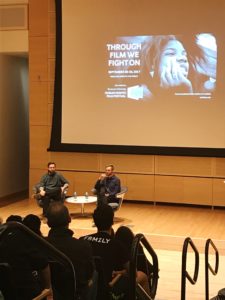Human Rights Film Festival: For Ahkeem
My list of hobbies is relatively short and includes watching films. What kind? Well, almost anything except horror films (they just don’t make sense to me).When I saw the poster for this year’s Human Rights Film Festival, I knew I couldn’t miss out. This year’s selections focused on belonging which I understood as belonging to a community, a specific place, a family, etc. depending on the context of each film. I didn’t see all of the films screened at the festival, but the ones I did see are worth a commentary. The opening night screening was a coming-of-age documentary, For Ahkeem.
In the opening scenes, the audience was introduced to 17-year-old Daje Shelton through a court appearance and subsequent placement in the Innovative Concept Academy. You may have heard of Innovative Concept Academy before, or read about it in this article from People. The Academy established by juvenile court Judge Jimmie Edwards to break the cycle of youth going to jail and being released only to find themselves in his courtroom time and time again. It is the only school in the U.S. overseen by the court system and focuses on rehabilitation through education.
Spanning the course of two years, the film chronicled Daje’s struggles in school, at home, and within her marginalized North St. Louis community. Despite her mother’s encouragement, Daje begins to shut down from all the pressure. Scenes where she is alert and engaged with friends or school faculty are juxtaposed with others in which she is nodding off while doing homework or sound asleep while watching television. At one point, she is lying on the couch in the counselor’s office listening to Gnarls Barkley’s “Crazy”, taking a break from it all. When the song ends, she immediately finds another to listen to, but the counselor insists it’s time for her to return to class and return to her responsibilities.
The death of Michael Brown within these two years magnified Daje’s story and highlighted the trials that often overshadow triumphs in the lives of many black teenagers, specifically those living in socioeconomically disadvantaged communities in America. It was chilling to see news coverage of Brown’s mother yelling at a local news correspondent about how hard it was to get Brown and other black boys in the neighborhood to graduate and make it out of the neighborhood.
I was rooting for Daje the moment she appeared on the screen. I was rooting for her to make the right decisions even when it was clear she didn’t know what to do. I was rooting for her to look her hurdles in the face and jump over them anyway. I’m still rooting for Daje as I write this and think about what Daje’s doing in the present. My heart sank during the scenes recalling the breaking news of Michael Brown’s death and the decision not to indict the officer involved in his murder, but what spoke to me the most were the parallels between Daje’s path and that of her boyfriend, Antonio.

I won’t give the film away because it’s worth watching; however, where they both start and end in this film is a powerful statement about the intersections of the school-to-prison pipeline, marginalized communities, gun violence and police brutality, and what it means to be an African American teenager living with these circumstances in the 21st century. I also enjoyed the post-screening Q&A with the directors, Jeremy S. Levine and Landon Van Soest. They updated the audience on where Daje is today and discussed why they thought Daje’s story was an important one to tell.
For more information about the film: http://forahkeemfilm.com/